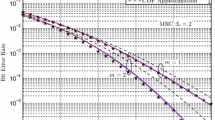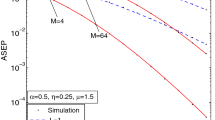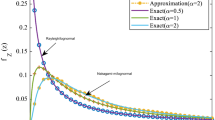Abstract
In this paper, the analytical expressions of the average symbol error probability (ASEP) for both coherent and non-coherent modulation formats with diversity schemes such as maximal ratio combining (MRC), equal-gain combining (EGC), and selection combining (SC) over the lognormal (LN) distribution assuming independent and identically distributed (i.i.d.) channels have been derived. The functions involving LN distribution are simplified using the Gauss–Hermit and Gaussian Quadrature integration. Furthermore, the effect of the diversity order and constellation size on the error probability has been examined extensively under various shadowing conditions such as infrequent light, average, and frequent heavy shadowing. As an application, the derived results are used to analyze the performance of the communication systems over the interference-limited environment. The impact of the number of interferers on important performance metrics such as the outage probability, the ASEP, and the channel capacity has been examined. The accuracy of the analytical results are validated by comparing them with the exact numerical results and Monte Carlo simulations. The analytical expressions are simple and easily implementable in software package such as MATLAB. The proposed analytical expressions are supposed to be a vital tool in areas such as IEEE 802.15.3a wireless communication system, indoor environment, radio channel effect by body worn devices, ultra-wideband indoor channel.













Similar content being viewed by others
References
Heliot, F., Ghavami, M., & Nakhai, M. R. (2008). An accurate closed-form approximation of the average probability of error over log-normal fading channel. IEEE Transactions on Wireless Communications, 7(5), 1495–1500.
Enserink, S., & Fitz, M. P. (2013). Estimation of constrained capacity and outage probability in lognormal channels. IEEE Transactions on Vehicular Technology, 62(1), 399–404.
Khandelwal, V., & Karmeshu, (2014). A new approximation for average symbol error probability over log-normal channels. IEEE Wireless Communications Letters, 3(1), 58–61.
Kundu, C., & Bose, R. (2013). An alternate method for calculating average probability of error in log-normal channel for UWB. In National Conference on Communication.
Singh, R., Soni, S. K., Raw, R. S., & Kumar, S. (2017). A new approximate closed-form distribution and performance analysis of a composite Weibull/log-normal fading channel. Wireless Personal Communications, 92(3), 883–900.
Khandelwal, V., Kaushik, R., & Jain, R. C. (2017). A simple closed form approximation of average channel capacity for weakly turbulent optical wireless links. Wireless Personal Communications, 95(3), 2665–2677.
Khandelwal, V., & Karmeshu, (2015). Channel capacity analysis over slow fading environment: unified truncated moment generating function approach. Wireless Personal Communications, 82, 2377–2390.
Shanker, P. M. (2012). Fading and shadowing in wireless systems. New York: Springer.
Laourine, A., Stephenne, A., et al. (2007). Estimating the ergodic capacity of log-normal channels. IEEE Communications Letters, 11(7), 568–570.
Olabiyi, O., & Annamalai, A. (2012). Invertible exponential-type approximations for the Gaussian probability integral \(Q(x)\) with applications. IEEE Wireless Communications Letters, 1(5), 544–547.
Abramowitz, M., & Stegun, I. A. (1972). Handbook of mathematical functions with formulas, graphs, and mathematical tables. New York: Dover Publications, Inc.
Tiwari, D., Soni, S. K., & Chauhan, P. S. (2017). A new closed-form expressions of channel capacity with MRC, EGC and SC over lognormal fading channel. Wireless Personal Communications, 97(3), 4183–4197.
Rana, V., Chauhan, P. S., et al. (2017). A new closed-form of ASEP and channel capacity with MRC and selection combining over inverse Gaussian shadowing. International Journal of Electronics and Communications (AEU), 74, 107–115.
Loo, C. (1985). A statistical model for a land mobile satellite link. IEEE Transactions on Vehicular Technology, 34, 122–127.
Loo, C. (1990). Digital transmission through a land mobile satellite channel. IEEE Transactions on Communications, 38, 693–697.
Steen, N. M., Byrne, G. D., et al. (1969). Gaussian quadrature for the integrals \(\int \limits _{0}^{\infty }e^{-x^2}f(x)dx\) and \(\int \limits _{0}^{b}e^{-x^2}f(x)dx\). Mathematics of Computation, 30, 661–671.
Simon, M. K., & Alouini, M. S. (1998). A unified approach to the probability of error for noncoherent and differentially coherent modulations over generalized fading channels. IEEE Transactions on Communications, 46(12), 1625–1638.
Trigui, I., et al. (2009). Outage analysis of wireless systems over composite fading/shadowing channels with co-channel interference. In Proceedings of IEEE WCNC-2009. https://doi.org/10.1109/WCNC.2009.4917874.
Karagiannidis, G. K., & Lioumpas, A. S. (2007). An improved approximation for the Gaussian Qfunction. IEEE Communications Letters, 11(8), 644–646.
Prudnikov, A. P., Brychkov, Y. A., & Marichev, O. I. (1986). Integral Series Vol. 1 Elementary functions. Amsterdam: Gordon and Breach.
Gradshteyn, I., & Ryzhik, I. (2000). Table of integrals, series, and products (6th ed.). New York: Academic Press.
Heliot, F., Chu, X., Hoshyar, R., & Tafazolli, R. (2009). A tight closed-form approximation of the log-normal fading channel capacity. IEEE Transactions on Wireless Communications, 8(6), 2842–2847.
Author information
Authors and Affiliations
Corresponding author
Rights and permissions
About this article
Cite this article
Chauhan, P.S., Soni, S.K. New Analytical Expressions for ASEP of Modulation Techniques with Diversity Over Lognormal Fading Channels with Application to Interference-Limited Environment. Wireless Pers Commun 99, 695–716 (2018). https://doi.org/10.1007/s11277-017-5137-8
Published:
Issue Date:
DOI: https://doi.org/10.1007/s11277-017-5137-8




